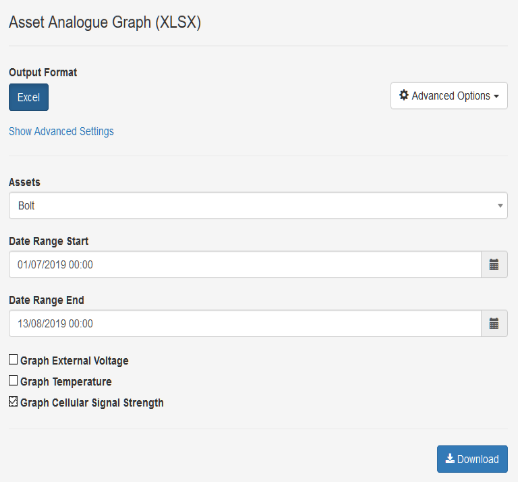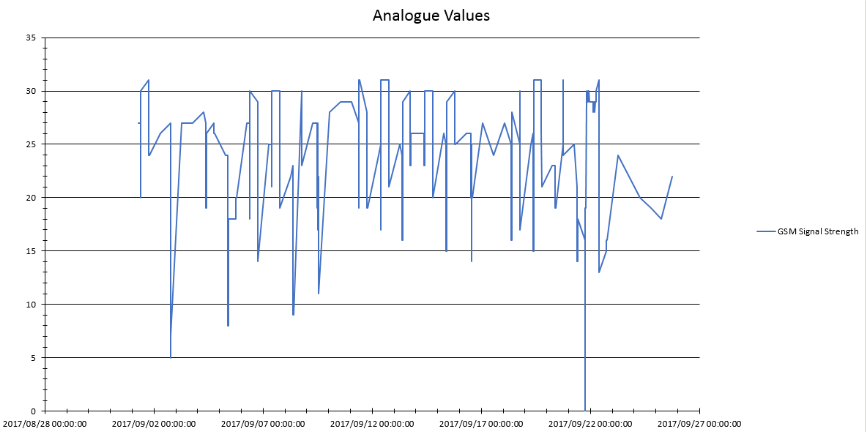Cellular Reception Troubleshooting
Typically we will notice a device is having trouble connecting due to delayed (or non-existent) updates. We can also spot this via the Device Statistics, which can be found on the Device Details page on Device Manager.
When checking Device Details on Device Manager, many failed uploads are a key giveaway that the device is in poor cell strength.
Digital Matter Cellular devices report their cellular signal strength in Analogue 4. The value reported is the signal strength seen at the beginning of the previous connection attempt.
Monitor Cell Signal Strength in Telematics Guru
The best way to check for a signal strength problem is to graph the value of Analogue 4. On Telematics Guru, this can be done with the Asset Analogue Graph Report:
Reports > View All Reports |
Asset Analogue Graph. |
 |
 |
When you download the resulting spreadsheet, it will have the data points in one sheet, and a graph of the selected analogues on another which could look something like the following:

uBlox SARA Modem Cell Strength
The value reported usually ranges from 0 to 31, and is interpreted as follows:
0: -113 dBm or less
1: -111 dBm
2: -109 dBm
//
30: -53 dBm
31: -51 dBm or greater
99: unknown
As shown below from uBlox's R410 documentation:

The threshold of usability is about 2, and strengths reach 31 easily when close to a cellular tower. However, were the antenna to snap off, you could expect the value to drop by 20-25 (40-50 dB). It would still be possible to connect when close to a tower, but the communications range would decrease by a factor of roughly 100.
But the strength is always 99 (unknown)?
For battery-powered devices, it is inevitable that the signal strength will almost always be reported as 99 (unknown). The CSQ (signal strength) is a value that is calculated by the modem during the connection. This calculation takes a bit of time. However in order to save power, to provide the longest possible battery life - our battery-powered devices will keep their modem on just long enough to upload data, and then immediately shut it off. So most of the time the value is 99.
In contrast powered devices stay connected to the network while in trip - so there will generally be CSQ values in analogue 4.
On battery-powered devices, there is no way to change this to force a signal strength report. It is simply there as a debugging tool rather than a coverage mapping tool. The modem reports it when it is available (which for battery-powered devices may not be often).
If your signal strength graph shows very low average values, and peak values lower than 15, despite the device being in an area with good coverage, it is reasonable to suspect an installation problem or a hardware fault.
- Check that the unit is installed in a location where its antenna will be effective
- Not inside a sealed metal box
- Not inside a 360-degree metal mesh enclosure with openings less than 20 cm wide
- Not right next to a source of electrical noise (certain cheap electronics, brush motors)
- The higher the better
- Examine the PCB for cracks in the solder at the antenna attachment points:

If you suspect a hardware fault, and the unit it is still under warranty, your distributor will be able to help you with further debugging, repair, or replacement.
Nordic Modem Cell Strength
For the Nordic-based devices, we return 0-32.
0: Cell strength is unknown, or less than -138dBm
1: -138dBm to -135dBm
2: -135dBm to -132dBm
3: -132dBm to -129dBm
…
32: CSQ > -45dBm
